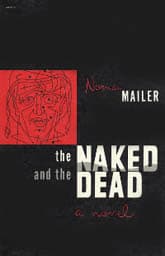The Naked and the Dead
Critique • Quotes • At the movies
 First edition
First editionFirst publication
1948
Literature forms
Novel
Genres
Literary
Writing language
English
Author's country
United States
Length
Approx. 300,000 words

Confronting the enemy in The Naked and the Dead.
The fun bunch go to war
The Naked and the Dead (1958): Director Raoul Walsh; writers Denis Sanders, Terry Sanders; featuring Cliff Robertson, Aldo Ray, Raymond Massey
There's much to enjoy in the only screen adaptation of Norman Mailer's American classic The Naked and the Dead. That is, if you've never read the book.
If you have read it, however, then you're probably wondering why any serious person would want to "enjoy" it. For readers, this Hollywoodized war story is a disaster.
Yes, I know, you shouldn't judge a film by a book—they're different media, different lengths, different intensities inherent in the formats, etc.
But, still, it's a shame in this case, because we come from the novel to the flick with expectations of something special, of an eye-opening, nihilistic depiction of war—perhaps something like All Quiet on the Western Front—but with an eye turned sharply to the social mores of America, including racial and class conflict. At least we hope for a gripping war movie following a desperate platoon of soldiers.
Disappointment sets in early.
Instead of getting quickly to the dramatic action like the novel, the movie opens by spending ages in social settings, including a night club, to establish the fun bunch of guys we're going to be following. The pratfalls and characterizations are embarrassingly broad. For the stone-cold killer Sergeant Croft we get ridiculously overacted flashbacks showing he's bad now because, you see, back in the States a woman done him wrong. Seriously. Meanwhile, Lieutenant Hearn's flashbacks show him as a dandy with an endless string of glamorous babes.
On the Pacific island, the platoon does have some effective battle scenes but most of the film then seems to be devoted to long shots of them ambling through lush vegetation.
Hearn, played efficiently by Cliff Robertson, has some dramatic scenes of confrontation with his mentor General Cummings (the always reliable Raymond Massey) over the comfortable life of officers versus the hell they put their men through, until he is dispatched to to join the platoon on a dangerous mission.
Aldo Ray, who in real life did do battle on a Pacific island (Iwo Jima), is credibly chilling as Croft, leading his men and the lieutenant to almost certain doom.
Hyperbolic trailer for the 1958 adaptation of The Naked and the Dead.
The movie's concluding battle scenes, in which the American forces suddenly turn the tables on the Japanese, thanks to the work of the platoon, are powerful. But the personal stories ruin the ending. Talk about sugar-coating. Who's killed and who survives is almost opposite to the book.
And in the end someone gets to make a speech to the general about how he's learned soldiers are really good men at heart, or some such drivel.
And not a single "fug" is to be heard on the whole island.
— Eric

